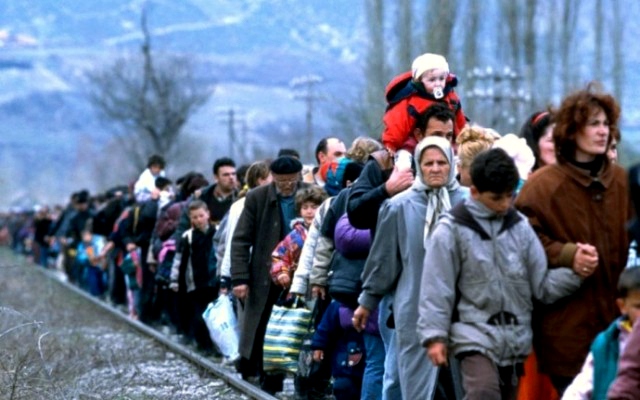Romani reflections on October 12, the Spanish National Day
by Pedro Casermeiro
Upon trying to transmit my reflections on October 12 through my computer’s keyboard, I will be journeying into a garden that can be challenging to leave. Whatever the case, I will always have the option of trying to walk back my steps and delete everything I have written. I will nonetheless try not to let the latter happen and attempt to express, with a degree of order and clarity, a few ideas that have not ceased to trouble me for some time now.
October 12 is the Day of Spanish Culture (“Día de la Hispanidad”), a Spanish National Holiday that coincides with the day in 1492 when Christopher Columbus first set foot in the Americas, even though he thought he had made it to Japan. What we are really celebrating is not the arrival of Columbus to the Americas but the importance of this event for the creation of the Spanish State, the unification of a number of peninsular territories under the monarchy of the Catholic Kings and the projection of Spanish culture and language.
And although for most people the celebration of this anniversary seems reasonable, many critical voices can also be heard. In Catalonia and in the rest of Spain there has been much controversy about the decision of Badalona’s local authorities not to commemorate the day and to work as if it were any other day of the year, on the grounds that 12 October 1492 gave rise to a process of cultural and human genocide. The colonisation of the Americas by European nations had one common denominator: the imposition of the culture, language and religion of the colonising countries and the forced eradication of indigenous cultures, languages and religions.
For many, this discussion may seem trivial. That is, because more than 500 years have passed since that time, one could say that the cultural genocide of indigenous peoples is, obviously, not what is celebrated today. However, I think it is very positive and healthy from a democratic point of view for us to be able to debate such issues in our country. And why is it positive that we can argue about it? Very simple: because very deep open wounds remain in our own country. While today we can emphasise the cultural genocide carried out in the Americas, no one seems to remember the other cultural genocide, the one that began in the late 15th century on the Iberian Peninsula and for which other peoples were victims. In 1499, seven years after the discovery of the Americas, the Catholic Kings enacted the first pragmatic decree against Roma and their way of life. And that was the precise moment when the Romani culture and people began their predicament of having to choose between exclusion, marginalisation or assimilation. And 600 years later we find ourselves basically in the same dilemma, with the social consequences we all know about.
Understanding history is the first step towards understanding the present and charting a future with a certain degree of harmony. The downside of the controversy these days is the way it is played out. It seems that we operate in an extreme world of political back and forth, in which within a week this whole issue will have been all but forgotten until next year. I think we need to study history, reclaim everything that was taken from us and analyse the consequences of it all. What we need is a pedagogical approach, not just a week-long political huff-and-puff. We need to delve deeper in a way that respects everyone and refrains from running roughshod over people’s feelings. Although 12 October for some symbolises the beginning of a genocide, it is also a day for celebrating the culture, language and national identity of a people, and thus must be respected, irrespective of its scope. And I repeat: we are not celebrating the annihilation of anyone, or celebrating against anyone. Hence, any conscientious objection about the celebration of this date should come from an empathetic and respectful position towards those who do celebrate it, while at the same time maintaining an assertive and pedagogical tone.
Would it make sense to ask that the date of this celebration be changed to avoid hurting people’s feelings? If the answer is yes, then it would also make sense for Roma to ask for each and every monument erected in honour of any monarch who had enacted a pragmatic decree against our culture or language to be torn down. This would seem barbarous. Yet it has been done and continues to be done regarding everything that harks back to the dictatorship of Francisco Franco, “El Caudillo”. Be that as it may, my answer to that question is a resounding no. The study of history should enrich us as a society and a democracy, and it must be done from the perspective of peace and neutrality that 600 years of shared history should have provided us with. We cannot judge what happened in the past based on our current values, as that would reflect a lack of perspective. We cannot pass judgement today on the Catholic Church for the Inquisition, nor can we now judge the monarchy or the Spanish state for a cultural genocide of Romani or indigenous peoples that occurred five centuries ago.
However, I insist that we do need to study and understand what happened and to promote restitution to the victims, in this case different peoples who, like Roma or Indigenous peoples, were forced to forget our language, our culture and our way of thinking . This issue is of vital importance to our people. After several decades of work in favour of the integration, inclusion or “whatever” of the Romani people, few have stopped to think that the first priority should be the full restoration of our people and our culture, with the focus on us as a people, a group, a nation and not as individuals seeking a better economic situation, which has been the focus of 99% of social policies targeted at Roma. As long as the prism has not changed and we are not seen as a people and treated as such, we will remain at our eternal crossroad: somewhere between marginalisation, exclusion and assimilation.
I hope these kinds of debates that are beginning to emerge do not slam the door shut, lead to entrenchment or become the kind of weapon that proponents of opposing political positions hurl at each other. I hope we can discuss and come to thoroughly understand the effects that current policies have on relations between peoples and cultures that are in constant contact with each other. I hope that someday it will come to be understood that the promotion of any culture should not entail offending or submitting another culture. And I hope it will also come to be understood that Roma are a people with their own culture and collective identity, and not a group of people with socioeconomic needs.
And on that point, I hope to be closer to finding my way out of the garden I had earlier decided to enter of my own free will.





